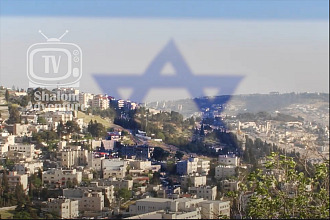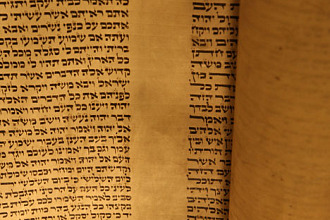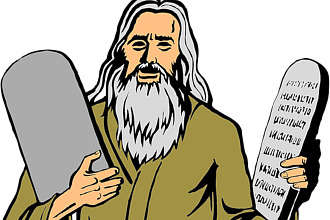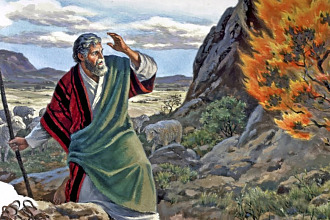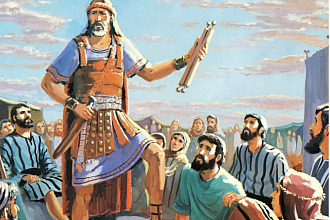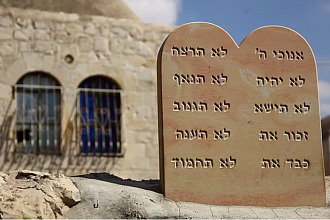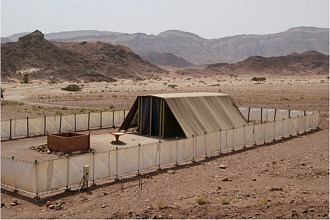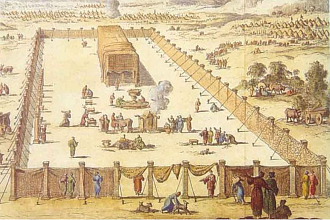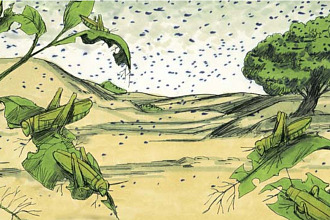Parasha for the Week: Chukah/Balak Numbers 19:1-25:9.
Haftarah for the Week: Micah 5:6-6:8.
Apostolic Writings: Luke 1:5-42.
Overview: Chukat:
The laws of the para aduma (the red heifer) are detailed. These laws are for the ritual purification of one who comes into contact with death. After nearly 40 years in the desert, Miriam dies and is buried at Kadesh.
The people complain about the loss of their water supply that until now has been provided miraculously.
Aharon and Moshe pray for the people’s welfare. G-d commands them to gather the nation at Merivah and speak to a designated rock so that water will flow forth. Distressed by the people’s lack of faith, Moshe hits the rock instead of speaking to it.
He thus fails to produce the intended public demonstration of G-d’s mastery over the world, which would have resulted had the rock produced water merely at Moshe’s word. Therefore, G-d tells Moshe and Aharon that they will not bring the people into the Land.
Bnei Yisrael resume their travels, but because the King of Edom, a descendant of Esav, denies them passage through his country, they do not travel the most direct route to Eretz Yisrael. When they reach Mount Hor, Aharon dies and his son Eleazar is invested with his priestly garments and responsibilities.
Aharon was beloved by all, and the entire nation mourns him 30 days. Sichon the Amorite attacks Bnei Yisrael when they ask to pass through his land. As a result, Bnei Yisrael conquer the lands that Sichon had previously seized from the Amonites on the east bank of the Jordan River.
Overview: Balak
Balak, king of Moav, is in morbid fear of Bnei Yisrael. He summons a renowned sorcerer named Bilaam to curse them. First, G-d speaks to Bilaam and forbids him to go. But, because Bilaam is so insistent, G-d appears to him a second time and permits him to go.
While en route, a malach (emissary from G-d) blocks Bilaam’s donkey’s path. Unable to contain his frustration, Bilaam strikes the donkey each time it stops or tries to detour.
Miraculously, the donkey speaks, asking Bilaam why he is hitting her. The malach instructs Bilaam regarding what he is permitted to say and what he is forbidden to say regarding the Jewish People.
When Bilaam arrives, King Balak makes elaborate preparations, hoping that Bilaam will succeed in the curse. Three times Bilaam attempts to curse and three times blessings issue instead.
Balak, seeing that Bilaam has failed, sends him home in disgrace.
Bnei Yisrael begin sinning with the Moabite women and worshipping the Moabite idols, and they are punished with a plague.
One of the Jewish leaders brazenly brings a Midianite princess into his tent, in full view of Moshe and the people.
Pinchas, a grandson of Aharon, grabs a spear and kills both evildoers. This halts the plague, but not before 24,000 have died.
"The Red Heifer"
Parashat Chukat begins with the moving of the people of Israel away from Mount Sinai and beginning their journey to the Promised Land. The path would not be a simple one, for while the desert was relatively uninhabited, and they were therefore generally able to make progress unmolested, they had now left the desert. “In the first month, the entire community of Bnei-Yisrael arrived at the wilderness of Zin. The people stayed at Kadesh.” (Numbers 20:1). It is a strange way to introduce this law, because it would have been easier to say: “this is the law of the red heifer,” but the Torah presents this statute as an archetype of the whole law and principle of Torah, the paradoxical aspect of this law—in one hand when the mixture is sprinkled on the defiled person he is cleansed, and on the other hand the one who is involved in the preparation of the red heifer become defiled— it is the sign that the Torah comes from God. The lack of logic of this law demonstrates the divine origin of the Torah.
Rabbi Noson Weisz says that as part of the transition of the generations, the deaths of the great leaders of the Exodus generation, Miriam and Aaron—as well as the irreversible verdict that condemns Moses to die on the wrong side of the Jordan and is the harbinger of his imminent demise — all appear in our Parasha. The theme of death positively dominates the first part of Chukat.”
This chok (rule) of the Red Heifer is one of the most famous in the Torah, but one of the most mysterious because it is unexplained. Reading the parashah we don’t find a rational explanation of this chok. This law reminds us of the answer the people of Israel gave to God when he spoke to them from the Sinai Naase Venishma (we will do and we will listen), meaning the people of God are ready to “do” without understanding first. They will listen after, if God is willing to give them an explanation.
This is the specificity of the Jewish people, always ready to obey even if they don’t understand. It is not the typical behavior of 21st century’s believers. We want to understand what the Bible says, even if we are not ready to do what is commanded. We don’t eat pork and other unclean animals, why? Just because God says we don’t have to eat unclean animals, or because science explains that these animals are not healthy? Jews don’t need any scientific explanation to keep the laws of God. The Torah and the Bible are beyond human understanding and we can only understand what God is willing to explain to us. However, the Bible was given to human beings and one of the mitzvot is to study the Bible in order to understand it.
“The Gift of Prophecy”
This parasha invites us to think about the biblical phenomenon of prophecy. The Bible introduces Bilaam as a man who had a relationship with G-d. He is never called a prophet, but G-d spoke to him, as two friends speak together. “And G-d came to Bilaam and said, “Who are these men with you?” (Numbers 22:9). We know that G-d has a people outside of His visible and physical people. They are faithful believers (Adam, Seth, Enoch, Methuselah, Noa, Shem, and others). Melchizedek and Jethro were priests of the most high, Melchizedek in the city of Salem (Jerusalem), Jethro in Midian. In this parasha we read about Bilaam who seems to be a recognized intermediary between G-d and men and to whom G-d spoke.
Maybe G-d spoke directly to Bilaam at a certain moment of his life; that is why Bilaam could have been a man of G-d. Maimonides confirms: “Prophecy can only be received by one who is extremely wise and learned, has mastered proper character traits, and battles and defeats his evil inclination constantly.” Thus, the Jewish tradition has a very positive view of Bilaam, who regard him as a Gentile prophet. He was “super-righteous,” holy, kind, and G-dly. He would analyze and criticize his own actions and continually work to grow spiritually. However, Rabbi Baruch Leff says that once Bilaam became a prophet, he was spiritually destroyed. He was not able to handle the powerful experience of prophecy, and it was at this point that he came to be the wicked Bilaam that we know.
Prophecy is not an artificial, superficial magic trick. It was only because Abraham was as great as he was, and he passed on his spiritual greatness to Isaac, who transmitted it to Jacob, and so on, that the people of Israel got great prophets as leaders. Bilaam was unable to handle prophecy because he had no nation backing him that was deserving of receiving it. According to the Jewish tradition, only the people of Israel had a history as rich and as holy as it was, firmly rooted in the Patriarchs and could receive the gift of prophecy.
When a spiritual gift as the gift of prophecy is given to a person and he can-not handle or maintain will corrupt him, making him into an evil person such as Bilaam.
"The Red Heifer and Mashiach"
This law is a perfect illustration of the mission of the Messiah. We have already said that the Torah is all about salvation through the Messiah, each ceremonial law - sanctuary, sacrifices, circumcision etc - are about the Messiah. That is why Yeshua said “Do not think that I came to abolish the Torah or the Prophets! I did not come to abolish, but to fulfill.” (Matthew 5:17), and later speaking to the leaders of Israel he said to them: “You search the Scriptures because you suppose that in them you have eternal life. It is these that testify about Me.” (John 5:39). How is this law of the Red Heifer referring to Yeshua the Messiah? As we said, the mixture prepared with the Red Heifer purifies the people of Israel and the sinner. However, at the same time the people who are preparing this sacrifice become unclean: “Also the one burning it is to wash his clothes and bathe his flesh with the water, and he will be unclean until evening. “A clean man is to gather up the ashes of the heifer and put them in a clean place outside the camp. They are to be for the community of Bnei-Yisrael to use as water of purification from sin. “The one who gathers the heifer’s ashes is also to wash his clothes as well as be unclean until evening. It will be a permanent statute for Bnei-Yisrael and for the outsider living among them.” (Numbers 19:8–10). Let’s think about these people who will become defiled; they are ready to serve, but they could ask, “Why should we become defiled for the sake of those who were not careful to avoid contact with a corpse?” Here is a great teaching of the Torah, when someone is ready to help his brother, he should be ready for “sacrifice.” It is a principle of the Torah “to be ready for self-sacrifice in order to save others.” This self-sacrifice principle could be to the point to give his life for the sake of his brother. “No one has greater love than this: that he lay down his life for his friends.” (John 15:13), and speaking about himself as the good shepherd he added, “I am the Good Shepherd. The Good Shepherd lays down His life for the sheep” (John 10:11). The law of the Red Heifer was perfectly fulfilled by Yeshua. He came on the earth to save us, and through his life he took on Him all our sins ““Surely He has borne our griefs and carried our pains. Yet we esteemed Him stricken, struck by God, and afflicted. But He was pierced because of our transgressions, crushed because of our iniquities. The chastisement for our shalom was upon Him, and by His stripes we are healed.” (Isaiah 53:4–5). He becomes defiled in order to save us. That is the great lesson of the Red Heifer.
The Jewish people made a strong connection between the Red Heifer and the Messiah. It is said, “Throughout the history of the Jewish people the ashes of nine red heifers were prepared, and the tenth one will be prepared when Mashiach comes. (See Yalkut Reuveini and Parah 3:5). If the Messiah has to prepare the Red Heifer, thus he will become unclean for the sake of his people; it is exactly what Yeshua has done for us.
Haftarah: Micah 5:6 - 6:8
According to Jewish tradition this Haftarah portion is a Messianic text. Rabbi Yitzchok Stavsky affirms that chapter 5 is about the king Messiah. In keeping with this theme, the chapter begins by focusing on the birthplace of King David, ancestor of the Messiah. Rabbi Stavsky notes: “Micah addresses the Davidic house and declares that due to their descent from Ruth the Moabite, it really would have been more proper that they be the least prominent members of the tribe of Judah. However, it is from this family that the Messianic king will emerge.” The beginning of verse 1 of chapter 5 speaks about the city where the Messiah was to be born, Bethlehem, and all believers know that this is the city where Yeshua was born 2000 years ago. Our Haftarah begins with verse 6 which speaks about the remnant of Jacob after the coming of the Messiah. The prophecy announcing the date of the coming of the Messiah (Daniel 9:24) mentions the destruction of the holy city as an abomination (Daniel 9:26-27). The people of Israel would be dispersed after this destruction. That is why the text of Micah says: “Now the remnant of Jacob will be in the midst of many peoples, like dew from Hashem,” (Micah 5:6). This text (vs. 6) is written in a future tense, and is about the remnant of Jacob after the coming of the Messiah (vs. 1). The poetry of Micah is written in parallel, that is why verse 6 is then restated in another way: “For the remnant of Jacob will be among the nations, in the midst of many peoples,” (vs. 7). When the text says “the remnant,” the prophet is speaking about faithful Jews, who are very often called “the righteous.” The fact that this remnant is compared to “dew from Hashem” or “abundant showers on grass” is a metaphor of the hope of salvation, and this salvation is from Hashem, exactly like the dew or rain comes from God who has established the rules of nature from Creation.
In the synagogues, this text is read in parallel with the parashah Balak that confirms that Israel cannot be cursed. Even though Bilaam was called and paid by Balak to curse Israel, this was not possible, and Bilaam says: “Look, I received a command to bless. He has blessed—I cannot change it! No misfortune is to be seen in Jacob, and no misery in Israel! Hashem their God is with them.” (Numbers 23:20-21). Our text in Micah also presents the protection of God upon the remnant of Jacob: “May your hand be raised up against your adversaries, and may all your foes be cut off” (Micah 5:8), and verifies that the enemies of Israel will be punished severely: “‘Now in that day’ —it is a declaration of Hashem— ‘I will cut off your horses among you, and I will destroy your chariots. I will cut off the cities of your land, and throw down all your strongholds. I will cut off sorceries from your hand, and you will have no more diviners. I will cut off your carved images and your sacred pillars from among you, so you will no longer bow down to the work of your hands. I will uproot your Asherah poles from among you, and destroy your cities. So I will execute vengeance in anger and wrath on the nations that have not listened.” (Micah 5:9-14). Even though some commentators have seen in this text a declaration of punishment against Israel, it is clear that it is punishment of the nations as specified in verse 14. The Messiah came to bless his people, and while it is true that the people of Israel lost national power and suffered very much during their exile, God was still there, protecting the remnant of Jacob.
Apostolic Writings: Luke 1:5 – 42
This text is at the very beginning of the gospel. “In the days of Herod, king of Judea, there was a priest named Zechariah, of the division of Abijah. And he had a wife from the daughters of Aaron, and her name was Elizabeth. And they were both righteous before G-d, walking blamelessly in all the commandments and statutes of the L-rd. But they had no child, because Elizabeth was barren, and both were advanced in years.” (Luke 1:5–7). In the parashah there are several mentions of Aaron.
In the text of Luke, Aharon is mentioned as the ancestor of Zechariah and his wife Elizabeth. In the biblical genealogy the father counts, thus Zechariah, as a descendant of Aharon, was a Cohen, “of the division of Abijah.” We know that the Cohanim, who were too many already in the time of king David, were divided into twenty-four classes, and each class was in duty in Jerusalem fifteen day a year. The rest of the time they were ministering to the Jewish people in their cities and villages. We have the description of these 24 Divisions of Cohanim in 1 Chronicles 24:7-18. Abijah, the ancestor of Zechariah was the head of the eighth division (10). This branch, which gave birth to Zechariah, was an important family, since he was chosen to enter the Beith Hamikdash, the Holy place of the Temple, to offer the incense to God. “Now it happened to be Zechariah’s time to serve as cohen before HASHEM in the order of his division. According to the custom of the priestly office, it became his lot to enter the Holy Place of HASHEM to burn incense.” (Luke 1:8–9).
The only indication we have about their place of living is in verse 39, as in the “hill country, a town in Judah.” According to the tradition it is Ein Kerem, today a suburb of Jerusalem.
The text gives us a precision to demonstrate how much this family was devoted to their duty and family tradition. It is about Zechariah’s wife, Elizabeth. It is written that she was also a “daughters of Aaron” which means both of them were descendants of Aaron. This indication tells us that Zachariah was a very pious Cohen, following the old prescriptions about marriage (Leviticus 21:7). The holiness of the Cohanim is mentioned several times in the Torah, and Zechariah’s concern for the purity of his heredity and his heritage made him marry someone who was not only from the tribe of Levi but the daughter of a Cohen.
The way the besorah narrates the story of this couple is a very Jewish way, in the style of the Tanach. They are introduced by a chronology and a genealogy. “In the days of Herod, King of Judah, there was a Cohen named Zechariah from the priestly division of Abijah. Elizabeth, his wife, was from the daughters of Aaron.” (Luke 1:5) Then the text describes the qualities of this couple. “They were righteous before HASHEM, walking without fault in all His commandments and instructions.” (Luke 1:6). The Hebrew translation of this text (MHNT) uses two Hebrew words to describe them: tsadikim for righteous, and tamim for their walk before Hashem. The word tam, which includes the notions of integrity, uprightness, purity, wholeness, completeness, blameless, and innocence, is very rarely used in the Tanach. It is about G-d in the Psalms, Yaakov (Genesis 25:27), and kind David (1Kings 9:4). Zechariah and Elizabeth were presented as “walking.” That means “faithful” to the Halachah which defines the mitsvoth and the chukim as the 613 commandments of the Torah listed by the Jewish scholars.
Another parallel of this couple with famous couples of the Tanach, “they were childless, because Elizabeth was barren and both of them were elderly.” (Luke 1:7) Elizabeth as were Sarah, Rivkah, Rachel, Anna… was barren, and their child was the result of a great miracle from God. This miracle is even greater than they were elderly, which is a parallel with the patriarch Avraham.
The besorah gives the story of this Jewish couple, because the miraculous child would be Yochanan HaMatbil (the Immerser), known as John the Baptist a great prophet in Israel who called his people to teshuvah (repentance). The testimony of Yeshua about him is eloquent. “Amen, I tell you, among those born of women, none has arisen greater than John the Immerser.” (Matthew 11:11). That means he was greater than Avraham or Moses.
The special point of this story is that Elizabeth was a relative to Myriam, the mother of Yeshua. The narrative says that when the angel Gabriel announced to Myriam that she would be pregnant and would give birth to Yeshua, he also said to her, “And behold, your relative Elizabeth in her old age has also conceived a son, and this is the sixth month with her who was called barren.” (Luke 1:36). That is why as soon as she could, she visited Zechariah and Elizabeth in Ein Kerem. “In those days Mary arose and went with haste into the hill country, to a town in Judah, and she entered the house of Zechariah and greeted Elizabeth. And when Elizabeth heard the greeting of Mary, the baby leaped in her womb. And Elizabeth was filled with the Holy Spirit, and she exclaimed with a loud cry, ‘Blessed are you among women, and blessed is the fruit of your womb’!” (Luke 1:39–42), an interesting text which helps us to know who Yeshua is. Many discussions have been raised about the genealogy of Yeshua, since the Mashiach had to be a “son of David.” It is clear in the Besorah that Yeshua was the adoptive son of Joseph who was a descendant of king David, and because we have two genealogy of Yeshua (Matthew 1 and Luke 3) some scholars have suggested that the genealogy of Matthew is about Joseph and the genealogy of Luke is about Myriam, his wife. But there is no evidence in the text that it is the case. The beginning of the text is clear. “Yeshua was about thirty years old when He began His ministry. He was the son (as was supposed) of Joseph, the son of Heli,” (Luke 3:23). Then we have the long list of his ancestors. If this genealogy was the one of Myriam, it would have been clearly stated. Since Myriam is a relative of Zechariah and Elizabeth, this suggests that Myriam and then Yeshua were related by some ramifications to Aaron the Cohen Gadol (high priest) and therefore to the Cohanim. Of course, the letter to the Hebrews says, “Now if He were on earth, He would not be a Cohen at all.” (Hebrews 8:4) This is because only the father counts. Even though His mother was related to Aaron, and the lineage of the Cohanim He could not be a Cohen. The text of Hebrews adds, “For it is clear that our Lord has sprung forth from Judah - concerning this tribe, Moses said nothing about cohanim.” (Hebrews 7:14). All the genealogy of Yeshua point to Judah and David, and that is why the first generations of believers in Yeshua were confident about his legitimacy as “Mashiach ben David,” and even the Jews of Jerusalem cheered him as the “Son of David” (Matthew 21:15).


